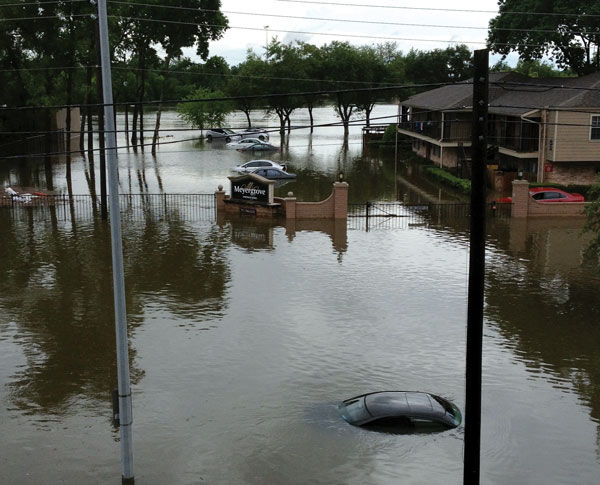Another year, another flood for Houston’s Jews. What now?
Published April 27, 2016
For the second consecutive year, this is a story that I wish I didn’t need to write. But for the second consecutive year, I’m left with no choice but to help my local Jewish community heal through the best way that I know how to do so—writing.
Leading up to May 2016, I was expecting to perhaps write a reflective piece on the one-year anniversary of Houston’s 2015 Memorial Day flood, which hit the city’s Jewish neighborhoods of Meyerland and Willow Meadows particularly hard. But my assignment editor—in this case, nature—had different plans.
On April 18, about 11 months after the previous flood, a deluge of similar magnitude wreaked renewed havoc on America’s fourth-largest city and its Jewish community. The 2015 flood damaged about 500 Jewish homes (among more than 2,500 homes overall) and three synagogues, including more than $1 million in damage for the congregation I belong to, United Orthodox Synagogues (UOS). The Jewish Federation of Greater Houston had already projected an 18-month recovery timetable, with a price tag of $3.5 million, for Jewish residents and their communal institutions following last year’s flood. It’s too early to assess the precise extent of the damage caused by 2016’s flood, which brought 16 inches of rain to the Houston area in less than a day, but the UOS synagogue facility was seemingly damaged even worse than it was last year.
In 2015, I lost a car in the Houston flood and had a brief frightening moment when an elevator I was riding in stalled at the bottom level. At the time, my minimal suffering paled in comparison to the plight of my synagogue and its home-owning families, about 80 of whom were affected by the flood and faced with life-altering decisions on how to rebuild their homes, or on the question of whether they could rebuild at all.
This year, the contrast was even sharper between my own experience and that of those who are most severely affected in the UOS community. I didn’t even lose a car, nor did I get stuck in an elevator. Homeowners in the synagogue community, meanwhile, are now faced with starting over from square one after already spending nearly a full year rebuilding or determining their rebuilding strategy. For this group, the material and psychological pain must be immeasurable.
The synagogue itself is again displaced from its main sanctuary and dealing with questions about its long-term physical home, the same questions that were already ubiquitous throughout this past year. It came in the form of rabbinical sermons for Shabbat, Tisha B’Av, and Yom Kippur, and the constant discussions among friends about the community’s housing crisis. Simply put, since May 2015, the flood essentially couldn’t be avoided in any aspect of communal life. For displaced homeowners, especially those who are displaced for the second year in a row, the natural question is, “What now?” For prospective homeowners in the synagogue community, including the so-called “young people” who are still renting apartments, the natural question could be, “Where to?” Synagogue leaders are trying their best to stay positive and upbeat.
“Thank you to everyone who has reached out…unfortunately we know the drill,” wrote UOS President Rick Guttman, whose home was among those already flooded last year, in an April 19 email to congregants. “However, we are immeasurably strengthened by our tremendous community that shows its strength in the way we treat each other like family…I am warmed by the reminder that our community, though suffering from flooding twice in less than a year, continues to provide support and comfort to those in need in such a way that Houston and the entire Jewish world can be proud of.”
As a member of the media coming at this event from a more personal perspective, I’m wondering whether the 2016 flood and the local Jewish community’s now-compounded plight will receive the attention it deserves. I can attest that journalists like myself often fall victim to “fatigue” when it comes to a repeat storyline. Instead of returning to the same topic, we choose to embark on a never-ending quest for novel stories and angles.
After 2015’s flood, will the 2016 Houston flood be old hat for national media? Certainly, there has been the requisite robust coverage from Houston’s secular media on the flood in general, and from our Jewish community newspaper, the Jewish Herald-Voice, on the flood’s devastating consequences for local Jews and their institutions. Yet after some simple Google searches, it’s apparent to me that national media aren’t following suit.
Last year’s flood brought the iconic image of Rabbi Joseph Radinsky, the septuagenarian rabbi emeritus of UOS and a prominent community leader, being rescued on a canoe. The image could subsequently be seen on Jewish news websites around the world. Today, Rabbi Radinsky is no longer with us. He died of pancreatic cancer in February. But the same heartbreaking images of local flooding have resurfaced, and I haven’t been seeing those photos pop up in as many places as they did last year.
That’s why I decided to take some time away from the U.S. presidential election, the Israeli-Palestinian conflict, and anti-Semitism on college campuses—among the other usual topics that a staffer at a nationally/internationally focused Jewish media outlet would cover these days—to write this essay. Even last year, it initially felt somewhat strange for me to “report” on a story taking place in my own community, a story that felt more like a life event than a news event. I had the same initial feeling this year, but I ultimately determined that silence isn’t the answer. The plight of Houston and its Jewish community is real, and intense. The Jewish future in a major city is at stake. I hope that my colleagues in this industry will take notice.














